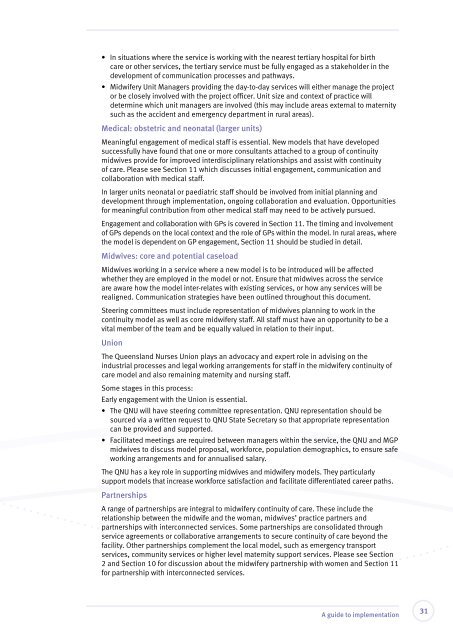Delivering continuity of midwifery care to Queensland women
Delivering continuity of midwifery care to Queensland women
Delivering continuity of midwifery care to Queensland women
Create successful ePaper yourself
Turn your PDF publications into a flip-book with our unique Google optimized e-Paper software.
• In situations where the service is working with the nearest tertiary hospital for birth<br />
<strong>care</strong> or other services, the tertiary service must be fully engaged as a stakeholder in the<br />
development <strong>of</strong> communication processes and pathways.<br />
• Midwifery Unit Managers providing the day-<strong>to</strong>-day services will either manage the project<br />
or be closely involved with the project <strong>of</strong>ficer. Unit size and context <strong>of</strong> practice will<br />
determine which unit managers are involved (this may include areas external <strong>to</strong> maternity<br />
such as the accident and emergency department in rural areas).<br />
Medical: obstetric and neonatal (larger units)<br />
Meaningful engagement <strong>of</strong> medical staff is essential. New models that have developed<br />
successfully have found that one or more consultants attached <strong>to</strong> a group <strong>of</strong> <strong>continuity</strong><br />
midwives provide for improved interdisciplinary relationships and assist with <strong>continuity</strong><br />
<strong>of</strong> <strong>care</strong>. Please see Section 11 which discusses initial engagement, communication and<br />
collaboration with medical staff.<br />
In larger units neonatal or paediatric staff should be involved from initial planning and<br />
development through implementation, ongoing collaboration and evaluation. Opportunities<br />
for meaningful contribution from other medical staff may need <strong>to</strong> be actively pursued.<br />
Engagement and collaboration with GPs is covered in Section 11. The timing and involvement<br />
<strong>of</strong> GPs depends on the local context and the role <strong>of</strong> GPs within the model. In rural areas, where<br />
the model is dependent on GP engagement, Section 11 should be studied in detail.<br />
Midwives: core and potential caseload<br />
Midwives working in a service where a new model is <strong>to</strong> be introduced will be affected<br />
whether they are employed in the model or not. Ensure that midwives across the service<br />
are aware how the model inter-relates with existing services, or how any services will be<br />
realigned. Communication strategies have been outlined throughout this document.<br />
Steering committees must include representation <strong>of</strong> midwives planning <strong>to</strong> work in the<br />
<strong>continuity</strong> model as well as core <strong>midwifery</strong> staff. All staff must have an opportunity <strong>to</strong> be a<br />
vital member <strong>of</strong> the team and be equally valued in relation <strong>to</strong> their input.<br />
Union<br />
The <strong>Queensland</strong> Nurses Union plays an advocacy and expert role in advising on the<br />
industrial processes and legal working arrangements for staff in the <strong>midwifery</strong> <strong>continuity</strong> <strong>of</strong><br />
<strong>care</strong> model and also remaining maternity and nursing staff.<br />
Some stages in this process:<br />
Early engagement with the Union is essential.<br />
• The QNU will have steering committee representation. QNU representation should be<br />
sourced via a written request <strong>to</strong> QNU State Secretary so that appropriate representation<br />
can be provided and supported.<br />
• Facilitated meetings are required between managers within the service, the QNU and MGP<br />
midwives <strong>to</strong> discuss model proposal, workforce, population demographics, <strong>to</strong> ensure safe<br />
working arrangements and for annualised salary.<br />
The QNU has a key role in supporting midwives and <strong>midwifery</strong> models. They particularly<br />
support models that increase workforce satisfaction and facilitate differentiated <strong>care</strong>er paths.<br />
Partnerships<br />
A range <strong>of</strong> partnerships are integral <strong>to</strong> <strong>midwifery</strong> <strong>continuity</strong> <strong>of</strong> <strong>care</strong>. These include the<br />
relationship between the midwife and the woman, midwives’ practice partners and<br />
partnerships with interconnected services. Some partnerships are consolidated through<br />
service agreements or collaborative arrangements <strong>to</strong> secure <strong>continuity</strong> <strong>of</strong> <strong>care</strong> beyond the<br />
facility. Other partnerships complement the local model, such as emergency transport<br />
services, community services or higher level maternity support services. Please see Section<br />
2 and Section 10 for discussion about the <strong>midwifery</strong> partnership with <strong>women</strong> and Section 11<br />
for partnership with interconnected services.<br />
A guide <strong>to</strong> implementation<br />
31
















